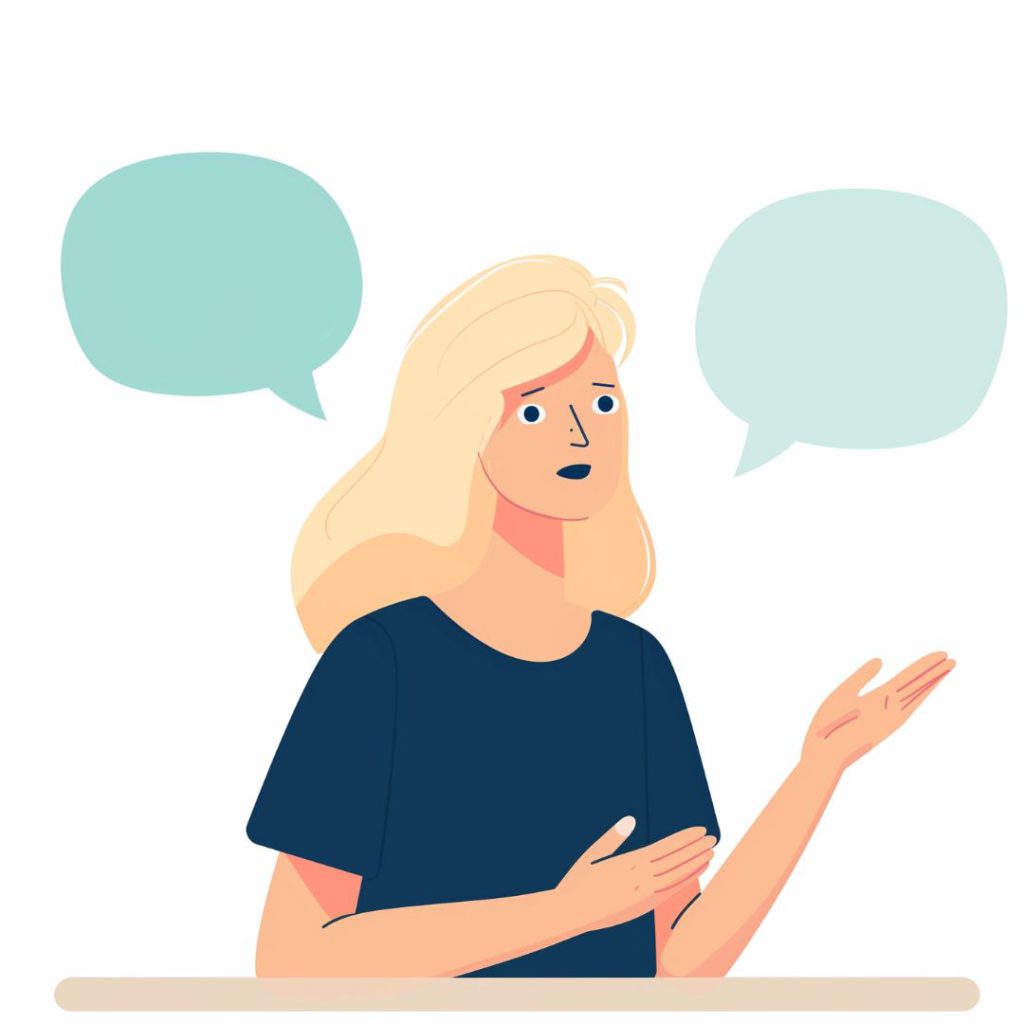Echolalia Treatment Options & Strategies

The repetition of words or phrases from others is called echolalia. It’s a phenomenon commonly associated with Autism Spectrum Disorder (ASD), but can also occur in other developmental conditions or even in typical development during early language acquisition.
Echolalia can be a tool for communication, a way for someone to express themselves by echoing what they hear.
On the other hand, it can also be a barrier to communication, making it difficult to have a back-and-forth conversation or express original thoughts. This is where treatment comes in.
By working with professionals and implementing specific strategies, individuals with echolalia can develop their communication skills and reduce their reliance on echoing.
This post will equip you with essential information about echolalia treatment goals, approaches, and the importance of personalized plans for overcoming communication challenges.
Why Consider Therapy for Echolalia?
Echolalia treatment isn’t simply about stopping someone from repeating phrases. It has a broader purpose aimed at empowering individuals with echolalia to communicate more effectively.
The ultimate aim of treating echolalia is to equip individuals with the ability to communicate their needs, wants, and ideas clearly and efficiently in everyday situations. This could involve requesting objects, expressing emotions, engaging in social interactions, or following instructions.
Echolalia treatment helps individuals to decrease their dependence on echolalia and encourage them to use more spontaneous and appropriate language in different contexts. This involves using their own words and phrases to initiate conversations, share thoughts and feelings, and respond to questions in a meaningful way.
| Related: Types of Echolalia | A Guide to Communication
Echolalia Treatment Approaches

Now that we understand the “Why”, let’s explore the “How”!
Echolalia treatment utilizes various evidence-based approaches to help individuals develop their communication skills.
Speech Therapy
Echolalia speech therapy is a key approach, especially for individuals with Autism Spectrum Disorder (ASD). A speech-language pathologist works with the person to identify the purpose behind echolalia. They might use techniques like:
- Cues-pause-point training: The therapist prompts the person with a cue (like a picture) and pauses to allow them to respond before giving the answer (the word related to the picture). This helps them learn to answer independently. If unsuccessful, they might give a gentle prompt like “Do you want to say…?” to nudge them towards the expecting answer.
- Script training: Teaches how to use language in social situations. Therapists help individuals understand social cues, greetings, turn-taking, and responding appropriately, reducing reliance on echolalia. This provides them with ready-made phrases for common situations.
- Building Vocabulary and Sentence Structure: Expands vocabulary and teaches proper sentence structure. Therapists introduce new words, practice using them, and show how to build sentences for clear communication.
| Suggestion: Echolalia & Autism | Is There A Connection?
Applied Behavior Analysis (ABA Therapy)
This therapy uses positive reinforcement to encourage desired behaviors and decrease echolalia. When someone uses spontaneous speech instead of echolalia, they get a reward (praise, a smile, or a preferred activity). This helps them understand the benefit of communicating their own thoughts.
For instance, imagine a child with echolalia repeats “What’s for lunch?” after every school activity. With ABA treatment for echolalia, the therapist would wait for the child to say “hungry” or point to their lunchbox. When they do, they get a thumbs up or a sticker. Over time, the child learns that saying “hungry” gets a positive response.
Functional Communication Training (FCT) is a specific approach within Applied Behavior Analysis (ABA) that targets challenging behaviors in individuals, particularly those on the Autism Spectrum Disorder (ASD) spectrum.
FCT focuses on identifying the purpose behind these behaviors (like getting attention) and teaching a more appropriate communication skill to achieve that goal (like saying “cookie” instead of a tantrum). This can involve verbal communication, sign language, picture cards, or gestures, all reinforced positively to encourage its use over challenging behaviors.
Visual Cues and Gestures
For some people, visual aids like picture cards or gestures can help with communication. Therapists might use these tools alongside spoken language to provide additional context and support understanding.
Imagine someone who echolalia “Open door” repeatedly. The therapist might show them a picture of a closed door and model the action of opening a door while saying “Open.” This can help connect the word with the action.
| Read more: Echolalia Without Autism
Cognitive Behavioral Therapy (CBT)
Cognitive behavioral therapy (CBT) can be a helpful approach for managing echolalia, particularly when it’s caused by negative thought patterns or anxiety. CBT helps individuals recognize the situations or thoughts that trigger echolalia. This awareness is the first step towards managing the behavior.
For instance, someone might echolalia more during social interactions due to social anxiety. CBT can help them identify these situations as triggers.
CBT also teaches individuals to challenge negative thoughts that contribute to echolalia. These thoughts might include:
- “I have nothing to say, so I’ll just repeat what others say.”
- “People will think I’m weird if I don’t echolalia.”
A therapist can help them develop more realistic and positive thoughts, like “I can participate in conversations by asking questions” or “It’s okay to take a pause before responding.”
| Discover: Echolalia in ADHD | Is Echolalia a Symptom of ADHD?
Echolalia Treatment: Does Age Make a Difference?

Echolalia treatment in adults follows similar principles as treatment in children, but with some adjustments to consider the different needs and communication abilities of adults.
Unlike children, adults can actively participate in their treatment plan, allowing therapists to work collaboratively with them to understand their specific goals. These goals might involve improving interactions at work, strengthening relationships, or navigating social settings more effectively. Due to the challenges echolalia can pose in social situations, a significant focus of treatment might be placed on developing these social communication skills.
Additionally, if the echolalia stems from an underlying neurological condition like a stroke or head injury, addressing that root cause becomes crucial. This might occur alongside speech therapy to achieve the most effective treatment plan. Ultimately, the success of treatment hinges on tailoring it to the individual’s specific needs and the underlying cause of their echolalia.
| Read more: Can You Have Echolalia as an Adult?
Echolalia Treatment at Home
While echolalia treatment is most effective with a qualified therapist, there are some speech therapy activities for echolalia that might be helpful.
Practicing Communication
- Use short, clear sentences and avoid complex vocabulary. This makes it easier for the person to understand and respond appropriately.
- After asking a question, give the person ample time to formulate their own response before repeating the question or filling the silence yourself.
- Utilize pictures, gestures, or written words alongside spoken language to provide additional context and support understanding.
- Encourage the person to ask questions using “who,” “what,” “where,” “when,” “why,” and “how.” This helps them initiate conversations and seek information.
- Acknowledge and praise attempts at independent communication, no matter how small. This encourages them to continue using their own words.
Fun Games and Activities
- Play simple games that involve turn-taking, like board games or card games. This encourages them to practice waiting for their turn and responding appropriately.
- Create stories together. Start a sentence and let the person finish it, or take turns adding phrases to a story. This helps with conversation flow and formulating their own thoughts.
- Role-play common social situations like greetings, ordering food, or asking for help. This provides practice using appropriate communication in different scenarios.
Remember:
- A noisy environment can be overwhelming and make it harder for someone to focus on communication.
- Avoid situations that might cause anxiety or overwhelm, which can worsen echolalia.
- Learning new communication skills takes time and patience. Celebrate small improvements and avoid getting discouraged.
- Home-based strategies are most effective when used alongside professional therapy.
HealWiser’s Last Piece of Advice
Echolalia treatment isn’t the same for everyone. It’s a personal path that helps people with echolalia reach their full communication abilities.
With the help of experts, people with echolalia can learn different ways to communicate better in everyday situations. This helps them feel more confident talking to others and building connections.
So, be there for them and support them every step of the way.
Sharing your experiences can provide valuable insights and emotional support. So…
…share your story with Heal Wiser and others in the comments section below this post.





